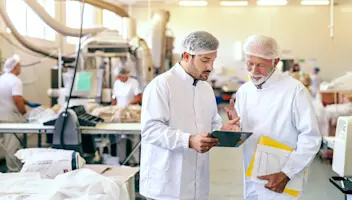How Dairy Companies Can Achieve Growth Again in 2021
How Dairy Companies Can Achieve Growth Again in 2021
How Dairy Companies Can Achieve Growth Again in 2021
18 Feb 2021
Aptean Staff Writer
As with every part of the global food industry, the dairy sector has faced great hardship throughout 2020. Already squeezed on profit margins, the impact of the pandemic was heavy. But despite uncertainty still remaining, dairy farmers and other industry stakeholders are approaching 2021 with optimism as they look to kickstart their growth.
How Has COVID-19 Affected the Dairy Industry?
The industry faced the kind of two-pronged threat from COVID-19 that will be familiar to businesses the world over. On the one hand, severe lockdowns caused significant supply chain disruptions, especially in the case of cross-border trade. But even once these were largely resolved after a period of adaptation, businesses still suffered a damaging drop in demand which is taking a long time to recover from.
The demand from the foodservice sector plummeted - in some cases to absolute zero in nations where the entire hospitality sector was put into hibernation. The demand from workplaces - traditionally a vital sales avenue for dairy businesses - also suffered badly. Taking the UK industry, of the estimated 9,200 dairy farmers in the country:
Around 500 had milk collections cancelled altogether
Around 5,200 suffered price drops
2,200 were asked to reduce production
500 had payments deferred
The impact of this has been stark across the world - with the European parliament estimating a €120million loss of revenue in the EU dairy industry. Businesses have been kept afloat through a combination of financial aid - for instance similar schemes in the US, UK and EU - and having to adapt business practices.
Dairy businesses could not shift their supply from foodservice to retail en masse as dairy products were already staple items for the vast majority of households and the extra demand simply wasn’t there. This led to a significant level of wastage. However, many were able to adapt to new production schedules to cut costs, while retaining capacity for an expected future rise in demand.
How Will the Industry Bounce Back in 2021?
Despite the nature of this year, there remains confidence in the industry’s ability to get back on a growth trajectory soon. The biggest priority for turning things around is halting the slide of the average milk price - which industry body the IFCN predict will fall to $30/100kg by March. However, a panel of experts at the IFCN global conference in September predicted a price rebound to $34-37/100kg by the end of next year if demand can be rekindled. They recommend that a number of steps need to be taken to make this a reality. These include:
Reconnecting with consumers
Embracing innovation - for instance through the uptake of specialist food software
Promoting the value of dairy in society
Consumer demands are changing. And although the base demand for dairy has remained strong for decades, attractive alternatives like soy and oat milk are making inroads into the market. In a post-COVID world where the industry will have to work hard to build demand back up to pre-pandemic levels, businesses will have to offer even more to customers. This may even include exploring the possibility of non-dairy alternatives themselves.
This includes committing to sustainable practices and transparency in the way milk is produced, and offering consumers the option to buy from suppliers local to them. It’s also a great irony that COVID-19 - a disease which has caused so much upheaval for the dairy industry - was a result of animal-to-human transmission. This has sharpened the importance of animal welfare in the mind of the public and regulators, and so continuing to strive for higher standards must be part of the industry’s response.
On the other hand, it is vital the dairy sector increases its efficiency and cost-effectiveness through improving its technology infrastructure. As dairy farmers continue to gear up for what will hopefully be a more fruitful 2021, the number of logistical challenges they will face - especially around managing production levels - will be huge. Now more than ever, the need for integrated software systems is crucial to provide the accurate insights and forecasting required to adapt to a fast-changing market.
ERP designed for the dairy industry can make this a reality for your business. Aptean Food & Beverage ERP is capable of bringing all data across your business onto the fully integrated Microsoft Dynamics platform, helping you make more accurate and always up to date decisions across all parts of an operation.
To find out more about how your business can benefit, get in touch with one of our dairy industry experts today.
Lebensmittel-Einblicke


Sind Sie bereit, Ihr Unternehmen grundlegend zu verändern?
Wir bieten Ihnen die spezialisierten ERP-Lösungen, die Sie für die Herausforderungen Ihrer Branche benötigen.






